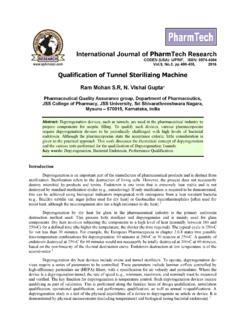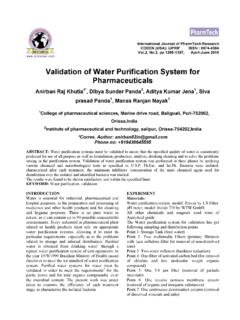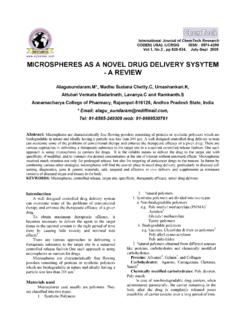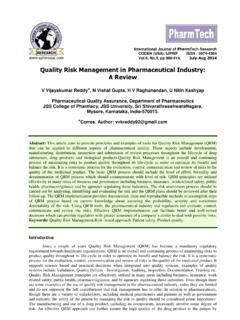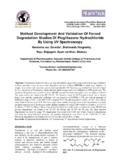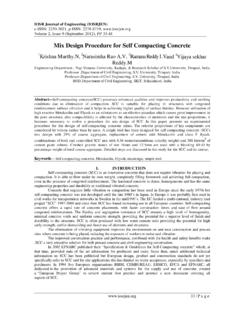Transcription of Hydroxyapatite Synthesis Methodologies: An Overview
1 International Journal of ChemTech Research CODEN( USA): IJCRGG ISSN : 0974-4290 , , pp 903-907, April-June 2010 Hydroxyapatite Synthesis methodologies : AnOverviewAmit Kumar Nayak*Seemanta Institute of Pharmaceutical Sciences, Jharpokharia, , India* : + : Hydroxyapatite (HAp) is the emerging most bioceramic, which is widely used in various biomedicalapplications, mainly in orthopedics and dentistry due to its close similarities with inorganic mineral component of boneand teeth. Synthetic HAp is known to be similar to naturally occurring HAp on the basis of crystallographic andchemical studies.
2 Several methodologies have been investigated and developed for the Synthesis of HAp. But, neweconomic and versatile methods for HAp Synthesis are of interest due to its immense importance and wide utilization inbiomedical applications. This review presents various well known methodologies for HAp Synthesis like precipitationtechnique, sol-gel approach, hydrothermal technique, multiple emulsion technique, biomimetic deposition technique,electrodeposition technique words: Hydroxyapatite ; Bioceramic; Precipitation technique; Sol-gel approach; Biomimetic depositionINTRODUCTIOND uring past few decades, considerableresearch efforts have been directed towards thesynthesis of various bioceramics for biomedicalapplications.
3 Among different classes of bioceramics, Hydroxyapatite (HAp) is the emerging mostbioceramic, which is widely used in variousbiomedical applications, mainly in orthopedics anddentistry. HAp has close similarities with inorganicmineral component of bone and teeth1. It possessesexceptional biocompatibility and unique occurring HAp is hexagonal in structure withthe chemical formula of one unit cell beingCa10(PO4)6(OH)25. The hydroxyl ion (OH-) od it canbe replaced by F-, Cl-, CO32-, etc in the collagen HAp is known to be similar tonaturally occurring HAp on the basis ofcrystallographic and chemical studies6.
4 Because,synthetic HAp is thermodynamically stable atphysiological pH5and osteoconductive, it has beenwidely used in hard tissue replacement andreconstruction applications, such as implant coatings7,and bone substitues8 etc. Its porous character alsooffers high binding affinity for a variety ofpharmacological substances such as antibiotics,hormones, enzymes, antibody fragments, steroids etc9-14. This has opened the potential for using syntheticHAp to deliver pharmacological substances in manyclinical applications with sustained release capacity forthe treatment of osteomyelitis, osteoporosis, osseouscancers etc in which local delivery is effective with theneed to fill defects in the skeleton.
5 New economic andversatile methods for HAp Synthesis are of interest dueto the importance of this material for variousbiomedical applications. The current communicationdeals with various methodologies for the preparationof synthetic HAp with optimum properties closer tothose of living hard tissues like bone and teeth, aimingat better and more effective biomedical FOR HAp SYNTHESISS everal methods have been utilized for thesynthesis of HAp include precipitation technique15-17,sol-gel approach18, hydrothermal technique19, multipleemulsion technique20, biomimetic depositiontechnique21-22, electrodeposition technique23 Kumar Nayak ChemTech ,2(2)904 Precipitation technique:The most popular and widely researchedtechnique for Synthesis of HAp is precipitationtechnique.
6 This technique is also called as wetprecipitation or chemical precipitation or aqueousprecipitation. This technique is chosen widely tosynthesize HAp in contrast to other , relatively large amount of HAp can beproduced by precipitation technique in absence oforganic solvents at a reasonable precipitation reaction for Synthesis ofHAp was first proposed by Yagai and Aoki, asindicated by Bouyer et al24. calcium hydroxide[Ca(OH)2] and orthophosphoric acid [H3PO4] werestarting materials of this reaction (equation 1). Theonly byproduct of this reaction was water and thereaction involved no foreign Ca(OH)2+ 6 H3PO4 Ca10(PO4)6(OH)2+ (1)The size, shape and surface area of the HApparticles obtained by this reaction are very sensitive tothe orthophosphoric acid addition rate and the reactiontemperature.
7 The orthophosphoric acid addition rate isstrongly linked to the pH obtained at the end of thesynthesis, and also to the suspension stabilization. Thereaction temperature determines whether the syntheticHAp crystals are monocrystalline or particles synthesized at low temperature (< 60 C)are monocrystalline25. Santos et al15has stated another two reactionsfor the Synthesis of HAp by precipitation technique. Inone of them, ammonium phosphate [(NH4) ] andCa(OH)2were starting materials (equation 2). Whereasin another reaction approaches, calcium hydrogenphosphate [Ca(H2PO4) ] and Ca(OH)2werestarting materials (equation 3). The pH was monitoredin both cases, but not corrected.
8 In the first reaction,the temperature of HAp Synthesis was maintained at40 C and in the second, Synthesis was done at roomtemperature. A higher temperature was used toenhance the reaction kinetics of HAp formation and toimprove Ca(OH)2 dissolution, although the HApprecipitation also have occurred at room Ca(OH)2+ 6 (NH4) Ca10(PO4)6(OH)2+ 6H2O + 12 NH4OH ..(2)7 Ca(OH)2+ 3 Ca(H2PO4) Ca10(PO4)6(OH)2+15 H2O ..(3)SyntheticHAp nanoparticles can be prepared by precipitationtechnique under stirring at room temperature and pH,10, as stated by Manuel et al17. The H3PO4 was addedto Ca(OH)2 until Ca/P = is started after NH4OH addition. Crystalgrowth was allowed for 24 hours and sinterationperformed at 1000 C for 1 et al1 has proposed an anotherpossibility of precipitation method, which involves awet chemical reaction of calcium nitrate [Ca(NO3) ], with (NH4) The grain size of thesynthesized HAp by this reaction can be controlled bychanging the reaction time and to obtain HAp with grain sizes < 100 nm,the solution requires continuous stirring at roomtemperature for 24 et al27 modified based on thehomogeneous precipitation technique using thefollowing reaction (equation 4).
9 Ca(EDTA)2- + 3/5 HPO42- + 2/5 H2O 1/10Ca10(PO4)6(OH)2 + HEDTA3- + 1/5 (4)The modification developed constituted of theaddition of urea for precipitation instead of NaOH,which led to more homogenous precipitation andfurther transformation to HAp due to pH changes forurea hydrolysis. The reaction temperature variedbetween 125 C and 160 approach:The sol-gel approach is an effective methodfor the Synthesis of nanophasic HAp, due to thepossibility of a strict control of process method offers a molecular level mixing of thecalcium and phosphorous, which is capable ofimproving the chemical of resulting HAp to asignificant extent.
10 Only limited attempts have beenreported on the sol-gel processing for the HApmaterials29-30. It has been reported that the HApmaterials synthesized by sol-gel process are efficient toimprove the contact and stability at theartificial/natural bone interfaces in bothin vitro andinvivo number of calcium and phosphorousprecursor combinations were employed for sol-gelsynthesis of HAp. Again, chemical activity and thetemperature required to form the apatite structuredepends largely on the chemical nature of theprecursors. Balamurugan et al28 used Ca(NO3)2. 4H2 Oand triethyl phosphate as calcium and phosphorousprecursor respectively, when the stoicheometric Ca/Pratio was maintained.
